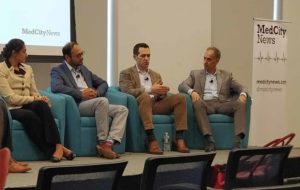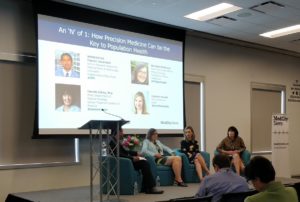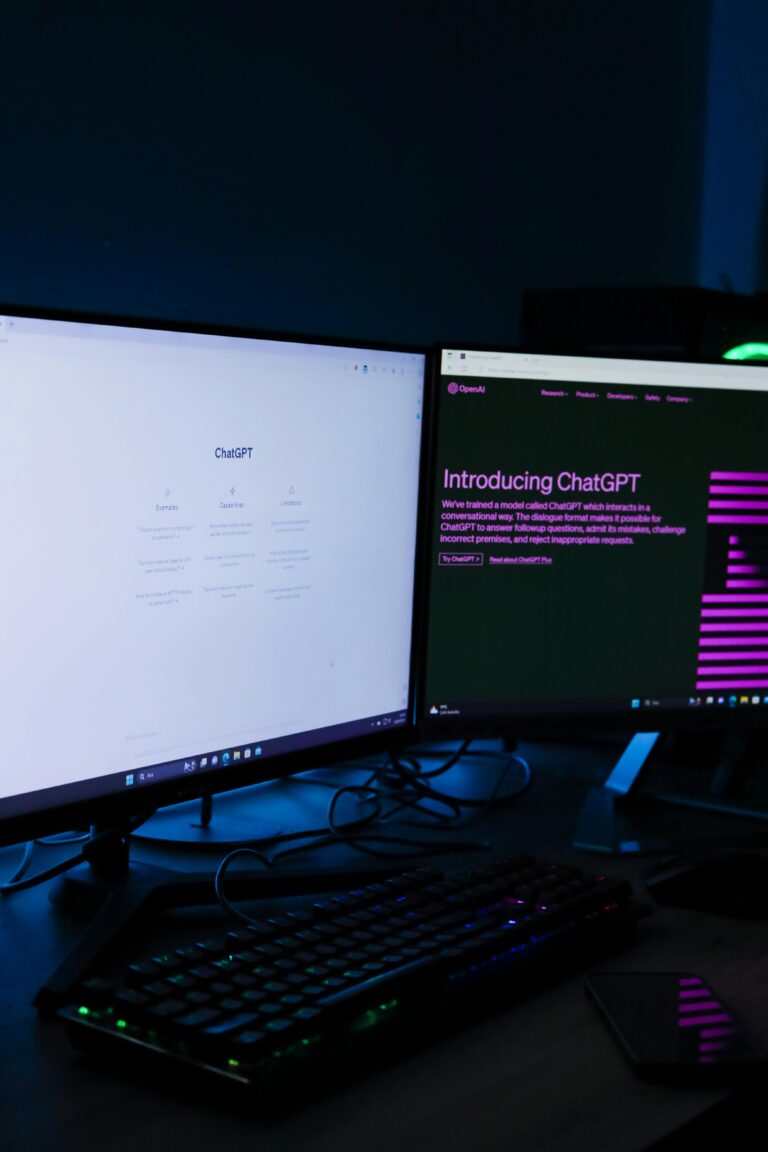Last week, the Arcweb team attended MedCity CONVERGE, an annual conference about digital healthcare innovation, and precision medicine organized by MedCity News.
 As in past years, 2019’s edition of MedCity CONVERGE featured a packed day of panels and presentations from every corner of the digital health landscape, with topics ranging from oncology precision medicine to patient engagement. Speakers ran the gamut from both up-and-coming startups to major institutions and companies.
As in past years, 2019’s edition of MedCity CONVERGE featured a packed day of panels and presentations from every corner of the digital health landscape, with topics ranging from oncology precision medicine to patient engagement. Speakers ran the gamut from both up-and-coming startups to major institutions and companies.
Here are our three big takeaways from the event.
Building a digital product?
Data has no value – not by itself, anyway
If there was any sacred cow of the digital health industry that found itself skewered during MedCity Converge, it was the idea that medical data has any intrinsic value.
“Our business is not about the data. Our data is about the clinical care.” That was how Caroline Savello of Color Genomics opened up the first panel of the day, An ‘N’ of 1: How Precision Medicine Can be the Key to Population Health. According to Savello, health systems have taken for granted the idea that there is enormous value in existing EMR data. But if that data is difficult to work with, or is failing to drive meaningful clinical outcomes across a wider population, how useful is it really?
To counter this, she explained, Color is focused on trying to bring precision medicine insights to population health scale, turning it into a tool that can help far more people than just a limited trial with a small population.
“We want to take these genomic and #PrecisionMedicine advances and determine which groups can benefit in the larger population.” @CancerCenter pic.twitter.com/HMzbUy0gqs
— Arcweb Technologies (@Arcweb) June 19, 2019
Nevenka Dimitrova, CTO of Oncology Informatics for Philips Healthcare, also highlighted the challenge of using EMR data. “Extracting data from an EMR is always an expedition,” she said, noting that the utility of the data is often limited by our ability (or, more often, inability) to effectively access it.
This idea of democratizing the benefits of precision medicine was also explored by Dr. Pamela Crilley, chair of the Department of Medical Oncology at Cancer Treatment Centers of America. Crilley pointed out that there are very different challenges in applying precision medicine techniques to a population of largely healthy people as opposed to one that has been pre-selected for a specific disease, as is currently the norm in the industry.

She also called attention to uneven clinical trial participation and its impact on the research side of precision medicine. According to Dr. Crilley, the only area of oncology where the majority of patients will be entered into clinical trials is pediatric oncology – and as a result, many recent advances have specifically come out of pediatric oncology.
Healthcare innovation can’t ignore the human factor
One of the most eye-opening stories of the day came from Roy Rosin, Chief Innovation Officer of Philadelphia’s Penn Medicine, who related the story of a telehealth early intervention program for people with COPD (Chronic Obstructive Pulmonary Disease). The Penn Medicine program had attempted to use telehealth to prevent emergency room visits from COPD patients, but ran into challenges along the way.
“We discovered that we could not prevent an emergency room visit without an in-person visit,” explained Rosin, speaking on the How Connected Health Can Improve Patient Experience/Outcomes panel. Once in-person visits were implemented, though, the program was widely successful. Rosin speculated that the high-stress nature of a COPD attack, which can leave a patient literally gasping for breath, made telehealth a less than optimal tool for in-the-moment intervention.
“The secret is not the technology but how you drive adoption.” – CIO Michael Vennera on @IBX‘s mobile experience strategy pic.twitter.com/O9b4UV6oy9
— Arcweb Technologies (@Arcweb) June 19, 2019
This story illustrates a common refrain from digital health innovators throughout the day: accounting for the human element of patient experience and its real-world implications is critical to successful digital health programs.
Michael Vennera, CIO of Independence Blue Cross, similarly highlighted the importance of accounting for experience, and noted that the key to the company’s mobile strategy actually lay in looking beyond the technology itself.
“The secret is not the technology but how you drive adoption,” Vennera explained. After all, it’s tough to drive change with a digital health program that people don’t actually use.
Deepti Jaggi, president of the healthcare data firm Clinakos, echoed Vennera’s comments and noted that it’s difficult to get people to add steps to an already cluttered healthcare landscape unless those steps are thoughtful and seamless. “Humans are wired for instant gratification,” explained Jaggi. “If we make the experience seamless, people will actually use it.”
Jaggi also noted that the same lesson is equally true for the provider side of the equation. “You have to align with the physician workflow,” she said. “You can’t just ask physicians to totally change their workflow.”
We can’t ignore the complex realities of the American health system
Working within the healthcare industry, there’s a tendency to become comfortable with the deep complexity of the American healthcare system. But it’s easy to forget that for the majority of people, healthcare in the U.S. is a black box – and MedCity CONVERGE’s array of speakers illustrated just how truly complex it really is.
Independence Blue Cross’s Michael Vennera noted that when the company first approached its mobile strategy they did so “as company insiders” – taking for granted that members had the same familiarity with the industry that they did. It was only once they did a more broad-base survey of member frustrations, said Vennera, that they understood that their members often confused different aspects of the healthcare system. (For instance, holding their insurance company for lack of appointment availability, or blaming doctors for a specific procedure not being approved.)

Christopher Boone, head of Real World Data & Analytics at Pfizer, called particular attention to the issue of understanding how and where data was gathered within the larger healthcare delivery system.
“For us, the context is the most important aspect of data, especially in the world of drug development,” said Boone. “It’s not just about the data capture. It’s about the pathway or the point in the clinical workflow that the data was captured.” He added that factors like whether the data was captured pre- or post-diagnosis are absolutely essential to making use of the data, especially if it’s to go before regulators like the Food & Drug Administration.
Innovators, dreamers, and newcomers
A significant chunk of the day was taken up by a pair of “David vs. Goliath” pitch sequences, where early stage companies pitched their solutions back to back. The companies ranged from targeted nutritional services for oncology patients to AI-assisted imaging solutions and novel data platforms.
Here are just a few of the companies that came to show off what they were working on.
@brycebeverlinII of Quench Medical explains their novel aerosol delivery system for lung cancer treatment. pic.twitter.com/JTTu3xEbHV
— Arcweb Technologies (@Arcweb) June 19, 2019
Eran Orr (@EranOrr ) of @XR_Health is using immersive VR/AR for cognitive therapy and pain treatment. pic.twitter.com/rAYiQTxIlB
— Arcweb Technologies (@Arcweb) June 19, 2019
@emigal of Ezra is developing wide-spectrum cancer screening using full-body MRIs assisted by AI, starting with prostate cancer. pic.twitter.com/0BEShHgGJl
— Arcweb Technologies (@Arcweb) June 19, 2019
"Physicians should be spending time with patients, not vendors." @MedialEarlySign 's Patrick Wells explains how they concentrated on finding clinical insight from the minimum amount of EHR data. pic.twitter.com/rRtIPpT84l
— Arcweb Technologies (@Arcweb) June 19, 2019
@CadexGenomics 's Greg Schafer is developing real-time monitoring for cancer immunotherapies. pic.twitter.com/LHX35qU5vs
— Arcweb Technologies (@Arcweb) June 19, 2019
Providers "don't know where to start" to find the right mobile health apps for their patients. @Andy_R_Pfau explains the far-reaching implications of the simultaneous rise of value-based care and mobile health apps, and how @Rx_Health helps doctors select the right ones. pic.twitter.com/abPuz0LsvU
— Arcweb Technologies (@Arcweb) June 19, 2019
MedCity CONVERGE 2019 was a great opportunity to get a birds-eye view of the state of both digital health in general and oncology innovation in particular. Kudos to MedCity News and all the speakers and participants for an excellent event.
Need help navigating the new regulations?
Want more healthcare innovation news? Make sure to subscribe to HealthWire and follow us on Twitter.




